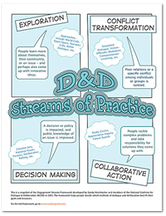 Did you ever wonder how Citizens Juries are different from Deliberative Polling? When should you use World Café, rather than Open Space? Or are Charrettes what's called for? First developed in 2005, NCDD’s Engagement Streams Framework (web version) helps people navigate the range of dialogue and deliberation approaches available to them, and make design choices that best fit their circumstance and resources. No method works in all situations, yet too often people become overly attached to the first D&D process they learn about -- and end up with less-than-satisfying results. Although it was designed for beginners to these processes, the tool also helps more seasoned practitioners understand where their own experience resides on the continuum, and which methods they may want to learn more about depending on the needs of their communities or clients. The framework presents two charts:
The full 8-page Engagement Streams Framework (.pdf) should be printed in color on 8.5 x 11 paper, front-and-back (so the charts line up across two pages). Download the print version of the doc. Last updated August 2014.
Here are a few ways people are using the framework:“The Engagement Streams Framework is a critical tool for us at the CPD as we initially evaluate potential projects for deliberative ripeness, and then again when we get down to process design. It succinctly introduces and organizes the diverse world of D&D in a very practical way. It’s simple enough for beginners to not get overwhelmed, but rich enough for more experienced practitioners to return to again and again.”
-Martín Carcasson, Colorado State University Center for Public Deliberation “I’ve found NCDD’s Engagement Streams Framework to be a very valuable tool when conducting workshops with local government staff and officials on how to improve public engagement practices. It not only helps give the big picture of what methods make sense to use when, but provides enough detail so that people can begin thinking about how they could apply these methods in their local engagement efforts.” -Diane Miller, Civic Collaboration “I love the Engagement Streams as a jumping off point to understanding what features you need in a deliberative process. It’s one of the best breakdowns I’ve seen for explaining the progression of complexity in implementation of the deliberative process. I trust NCDD, which is regularly looking at ALL the methods in play, to do a sound analysis as opposed to people who might be seated in a particular practice or approach. This kind of logical analysis from the community itself is invaluable for technologists to build applications that effectively support dialogue and deliberation.” - Ele Munjeli, Web Developer “When I was working on my report on the civic engagement landscape in Chicago, I had no idea how to organize the thousands of diverse pieces of information I’d collected into a coherent narrative. As I thought through options, the information naturally seemed to cluster into four areas, strikingly reminiscent of the four NCDD Engagement Streams. At first, I hesitated using that framework, designed to categorize methods, to segment a city’s organizations and projects. Surprisingly though, it has proven the single most valuable tool in helping Chicagoans understand the local D&D field.” - Janice Thomson, Stakeholder Engagement Consultant “I use the framework in both leadership training and traditional teaching environments. I found it very helpful for adults taking leadership courses who often had little experience with dialogue, as the framework helped them “get it” and differentiates dialogue from other processes. It also quickly gave them several models of dialogue, so they understood that there are many ways to approach it. With professors and students who are engaged in “Difficult Dialogues” classes at UT Austin, focusing on challenging topics such as immigration, science and religion, and HIV, the framework helps them understand what I mean when I say “Dialogue is NOT your usual classroom discussion” and gives them a useful context for learning how to talk about these controversial topics in a meaningful and productive way.” - Juli Fellows, Organizational Consultant and Trainer “We built the Streams of Engagement framework into our online Issue Guide Exchange. When someone uploads a guide to the tool we give them the option of identifying which streams of practice the guide addresses. Then, when someone is searching for guides, the streams of practice provide them with another way to figure out which guides will best meet their needs.” - Carrie Boron, formerly of Everyday Democracy “I just discovered the framework and am using it in a group facilitation workshop I’m teaching to AmeriCorps interns. My intent is to get them to think about what type of facilitation they are attempting and what outcomes they are looking for, and then look at what methods make the most sense, given the desired outcomes.” - Marty Jacobs, Systems In Sync “I’ve used the engagement streams cartoon mostly, since it’s a great tool for introducing people to the ideas of different uses for the methods. I’ve used it and prepared it for Carolyn [Lukensmeyer] to use at presentations for United Way leadership, state elected officials, and college classrooms.” - Susanna Haas Lyons, formerly of AmericaSpeaks Web Version (373KB) Print Version (3.5 MB) We also recommend you download NCDD's Resource Guide on Public Engagement which features the engagement streams in full.
0 Comments
Your comment will be posted after it is approved.
Leave a Reply. |
Categories
All
|
Follow Us
ABOUT NCDD
NCDD is a community and coalition of individuals and organizations who bring people together to discuss, decide and collaborate on today's toughest issues.
© The National Coalition For Dialogue And Deliberation, Inc. All rights reserved.
© The National Coalition For Dialogue And Deliberation, Inc. All rights reserved.


 RSS Feed
RSS Feed